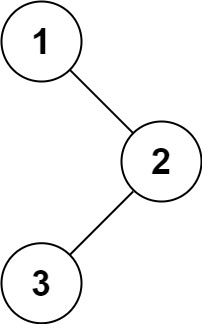94.二叉樹的中序遍歷
給定一個二叉樹的根節點?root?,返回?它的?中序?遍歷?。
示例 1:

輸入:root = [1,null,2,3] 輸出:[1,3,2]
示例 2:
輸入:root = [] 輸出:[]
示例 3:
輸入:root = [1] 輸出:[1]
提示:
- 樹中節點數目在范圍?
[0, 100]?內 -100 <= Node.val <= 100
進階:?遞歸算法很簡單,你可以通過迭代算法完成嗎?
思路:類似于我們之前講過的遞歸算法中序遍歷二叉樹:二叉樹的遍歷
? ? ? ? 這里我們需要返回的是數組,數組中的元素是按照中序遍歷的順序,同時返回數組的大小,也就意味著我們需要先計算二叉樹的大小,該方法我們在二叉樹的遍歷中同樣也實現了
代碼實現:
int TreeSize(struct TreeNode* root){if(!root){return 0;}return 1+TreeSize(root->left)+TreeSize(root->right); }void Inorder(struct TreeNode* root,int*arr,int* index){if(!root){return;}Inorder(root->left,arr,index);arr[*index]=root->val;(*index)++;Inorder(root->right,arr,index); }int* inorderTraversal(struct TreeNode* root, int* returnSize){if(!root){* returnSize = 0;return NULL;} int size = TreeSize(root);* returnSize = size;int* arr = (int*)malloc(sizeof(int)*size);int index = 0;Inorder(root,arr,&index);return arr; }
145. 二叉樹的后序遍歷
145. 二叉樹的后序遍歷
給你一棵二叉樹的根節點?root?,返回其節點值的?后序遍歷?。
示例 1:
輸入:root = [1,null,2,3]
輸出:[3,2,1]
解釋:

示例 2:
輸入:root = [1,2,3,4,5,null,8,null,null,6,7,9]
輸出:[4,6,7,5,2,9,8,3,1]
解釋:

示例 3:
輸入:root = []
輸出:[]
示例 4:
輸入:root = [1]
輸出:[1]
提示:
- 樹中節點的數目在范圍?
[0, 100]?內 -100 <= Node.val <= 100
算法思路:與我們的中序遍歷一樣:思路同樣參考二叉樹的遍歷
代碼實現如下:
int TreeSize(struct TreeNode* root){if(!root){return 0;}return 1+TreeSize(root->left)+TreeSize(root->right); }void PostOrder(struct TreeNode* root,int*arr,int* index){if(!root){return;}PostOrder(root->left,arr,index);PostOrder(root->right,arr,index);arr[*index]=root->val;(*index)++; }int* postorderTraversal(struct TreeNode* root, int* returnSize){if(!root){* returnSize = 0;return NULL;} int size = TreeSize(root);* returnSize = size;int* arr = (int*)malloc(sizeof(int)*size);int index = 0;PostOrder(root,arr,&index);return arr; }
好了,本期關于二叉樹的遍歷就到這里結束了,相信大家對于二叉樹的遍歷已經十分得心應手了,這里遞歸的思想非常重要,但是對于那些比較大的樹,深樹,遞歸的方式往往容易棧溢出。我們會采取迭代加棧與隊列以及層序的方式來完成--這些內容會留到c++部分進行講解。謝謝大家的點贊和收藏!!
可以保證消費不被重復消費嗎,可以多個消費者,但是需要保證同一個消息,不會被投遞給多個消費者)









編程示例程序)







———模板)
